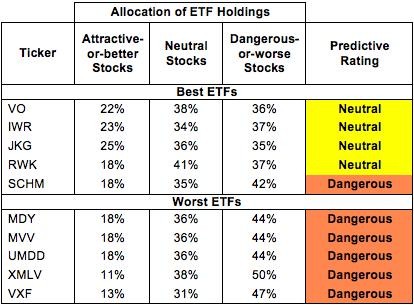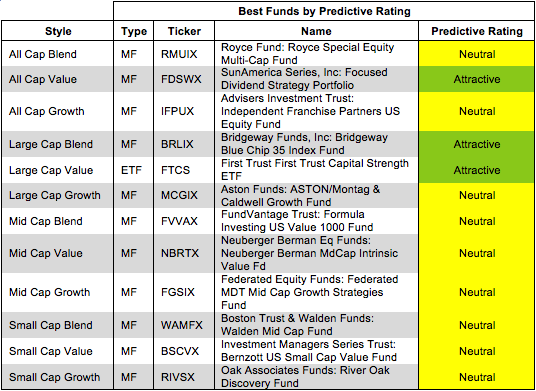Best And Worst MidCap Growth Style ETFs Mutual Funds And Key Holdings
Post on: 1 Апрель, 2015 No Comment

Summary
- Lists of the Best and Worst ETFs and Mutual Funds in the Mid-Cap Growth Style.
- Distribution of all Mid-Cap Growth Style ETFs and Mutual Funds across our Predictive Rating Scale.
- Ratings are based on rigorous analysis of the profitability and valuation of each fund’s holdings.
- Our rating system is forward-looking and does not rely on past performance.
The Mid Cap Growth style ranks seventh out of the twelve fund styles as detailed in my Style Rankings for ETFs and Mutual Funds report. It gets my Dangerous rating, which is based on aggregation of ratings of 10 ETFs and 389 mutual funds in the Mid Cap Growth style as of July 29, 2014. Prior reports on the best & worst ETFs and mutual funds in every sector and style are here .
Figure 1 ranks from best to worst the nine mid cap growth ETFs that meet our liquidity standards and Figure 2 shows the five best and worst rated mid-cap growth mutual funds. Not all Mid Cap Growth style ETFs and mutual funds are created the same. The number of holdings varies widely (from 24 to 583). This variation creates drastically different investment implications and, therefore, ratings. The best ETFs and mutual funds allocate more value to Attractive-or-better-rated stocks than the worst, which allocate too much value to Neutral-or-worse-rated stocks.
To identify the best and avoid the worst ETFs and mutual funds within the Mid Cap Growth style, investors need a predictive rating based on (1) the stocks ratings of the holdings, (2) the all-in expenses of each ETF and mutual fund, and (3) the fund’s rank compared to all other ETFs and mutual funds. As a result, only the cheapest funds with the best holdings receive Attractive or better ratings. Investors need not rely on backward-looking ratings. My fund rating methodology is detailed here .
Investors seeking exposure to the Mid Cap Growth style should buy one of the Attractive-or-better rated ETFs or mutual funds from Figures 1 and 2.
Get my ratings on all ETFs and mutual funds in this style by searching for Mid Cap Growth on my mutual fund and ETF screener.
Figure 1: ETFs with the Best & Worst Ratings — Top 5
* Best ETFs exclude ETFs with TNAs less than $100 million for inadequate liquidity.
Sources: New Constructs, LLC and company filings
PowerShares Fundamental Pure Mid Growth Portfolio ETF (NYSEARCA:PXMG ) is excluded from Figure 1 because its total net assets (NYSEARCA:TNA ) are below $100 million and do not meet our liquidity minimums.
Figure 2: Mutual Funds with the Best & Worst Ratings — Top 5
* Best mutual funds exclude funds with TNAs less than $100 million for inadequate liquidity.
Sources: New Constructs, LLC and company filings
Brown Cap Management Mid Cap Fund (MUTF:BCMIX ) and DSM Small-Mid Cap Growth Fund (MUTF:DSMMX ) are excluded from Figure 2 because their total net assets are below $100 million and do not meet our liquidity minimums.
iShares Russell Midcap Growth Index ETF (NYSEARCA:IWP ) is my top-rated Mid Cap Growth ETF and Fidelity Growth Strategies Fund (MUTF:FAGKX ) is my top-rated Mid Cap Growth mutual fund. IWP earns my Neutral rating and FAGKX earns my Attractive rating.
QuantShares U.S. Market Neutral Momentum Fund ETF (NYSEARCA:MOM ) is my worst-rated Mid Cap Growth ETF and Mutual Fund Series Trust: Eventide Gilead Fund (MUTF:ETAGX ) is my worst-rated Mid Cap Growth mutual fund. MOM earns my Neutral rating and ETAGX earns my Very Dangerous rating.
Figure 3 shows that 141 out of the 1493 stocks (over 8% of the market value) in Mid Cap Growth ETFs and mutual funds get an Attractive-or-better rating. However, 0 out of 10 Mid Cap Growth ETFs and only 12 out of 389 Mid Cap Growth mutual funds (less than 1% of total net assets) get an Attractive-or-better rating.
The takeaways are: mutual fund managers allocate too much capital to low-quality stocks and Mid Cap Growth ETFs hold poor quality stocks.
Figure 3: Mid Cap Growth Style Landscape For ETFs, Mutual Funds & Stocks

Sources: New Constructs, LLC and company filings
As detailed in Cheap Funds Dupe Investors , the fund industry offers many cheap funds but very few funds with high-quality stocks, or with what I call good portfolio management .
Investors need to tread carefully when considering Mid Cap Growth ETFs and mutual funds, as no ETFs and only 12 mutual funds in the Mid Cap Growth style allocate enough value to Attractive-or-better-rated stocks to earn an Attractive rating.
TRW Automotive Holdings Corp (NYSE:TRW ) is one of my favorite stocks held by Mid Cap Growth ETFs and mutual funds and earns my Attractive rating. It also makes my Most Attractive stocks list for September. Since 2006, TRW has grown after-tax profits (NOPAT ) by 17% compounded annually. The company has also increased return on invested capital (ROIC ) from 6% in 2006 to a top quintile 15% in 2013. Investors have taken notice of this outstanding profit growth, and the stock is up over 40% in 2014. Luckily, there is still plenty of upside left in TRW. At its current price of
$102/share, TRW has a price to economic book value (PEBV ) ratio of 1.2. This ratio implies the market expects TRW to grow NOPAT by just 20% over the rest of its corporate life. This expectation is rather low for a company that has grown profits by almost 20% compounded annually for the past seven years.
Cree Inc. (NASDAQ:CREE ) is one of my least favorite stocks held by Mid Cap Growth ETFs and mutual funds and earns my Dangerous rating. Over the past eight years, CREE has grown NOPAT by only 2% compounded annually and its ROIC has fallen from 10% to a bottom-quintile 4%. CREE hasn’t generated positive economic earnings in any year of my model, which goes back to 1998. Despite CREE’s slow NOPAT growth and declining profitability, significant growth is still priced into the stock. To justify its current price of
$43/share, CREE must grow NOPAT by 16% compounded annually for the next 46 years. It seems unlikely that a company that has grown NOPAT by just 2% compounded annually for nearly a decade would be able to suddenly grow at such increased levels, not to mention for 46 years. Overly optimistic expectations coupled with slow NOPAT growth make CREE a stock to avoid.
Figures 4 and 5 show the rating landscape of all Mid Cap Growth ETFs and mutual funds.
My Style Rankings for ETFs and Mutual Funds report ranks all styles and highlights those that offer the best investments.
Figure 4: Separating the Best ETFs From the Worst Funds
Sources: New Constructs, LLC and company filings
Figure 5: Separating the Best Mutual Funds From the Worst Funds
Sources: New Constructs, LLC and company filings
Review my full list of ratings and rankings along with reports on all 10 ETFs and 389 mutual funds in the Mid Cap Growth style.
Kyle Guske II contributed to this report.
Disclosure: David Trainer and Kyle Guske II receive no compensation to write about any specific stock, sector, style or theme.
Disclosure: The author has no positions in any stocks mentioned, and no plans to initiate any positions within the next 72 hours. (More. ) The author wrote this article themselves, and it expresses their own opinions. The author is not receiving compensation for it. The author has no business relationship with any company whose stock is mentioned in this article.














